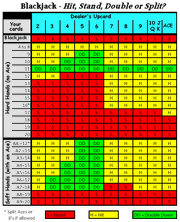When To Double Down And Split
- When you have a hard 10 or 11 card against any dealer’s low-card, you should double down. Meaning that when you have two cards that total 10 or 11 without an ACE, it’s a hard 10 or 11. It could be any of the combination 2-8, 2-9, 3-7, 3-8, 4-6, 4-7, 5-6, and so on. As long as the dealer has a lower cand than you, you should always double down.
- TWO 8s: sixteen is a lousy total to work from, but splitting the 8's gives you a 62% chance that at least one of your hands will give you 18 or even a soft 19. Some people argue that if the dealer is showing 9 or 10, then don't split and hit on your 16. It's your decision!
- When you are allowed to Double Down After Split, you’re going to split 2’s and 3’s when the house has the upcards of 2 through 7. You’re going to split fours (4,4) when the house shows a 5 or 6, and 6’s are split when the house shows 2 through 6. When DDAS is not available, you will absolutely be splitting less.
Whether it's A4 to double A5s or A3 into two A4s, whether it's landscape or portrait oriented, you don't have to configure anything. The program will auto-configure itself and detect the best way to split. Just click the Split button to get your result PDF. Example: You scanned a book by flipping each page and laying it face down on the scanner.

INSURANCE
If the dealer's upcard is an ACE, he has a 4/13 (31%) chance of getting a Blackjack. You might be allowed to place an extra insurance bet. This is half your stake, and if the dealer does get Blackjack, it pays 2:1 which will effectively return your whole stake on the hand. However, as the dealer's chance of Blackjack is slightly less than 1/3, over time the casino makes a profit of about 2.5% on insurance bets. Therefore insurance is not generally recommended.
WHAT IS CARD COUNTING?
If you're playing with a single deck and you see the dealer's upcard is an ace, you know your own chance of receiving an ace is reduced. That's simple!
However, you will usually be playing a game where up to 8 decks are mixed together. A blank plastic card is inserted near the bottom of the deck. The shuffled cards are then stacked in a 'shoe' from which they are drawn one at a time as required and then discarded. When the blank appears, all the the cards are brought back together, shuffled and then dealing starts from the top again.
Keeping track of what has been played from multiple decks requires a great deal more skill, but it can be worth it. If a lot of low cards have come out (A-9) this means that a higher than usual proportion of 10-value cards are left. This offers a slight advantage to the player, so it's time to raise your bets. By contrast, if a lot of 10 cards have come out, it's better to keep bets low or even stop playing.

Experts have developed several methods of card counting to help you beat the dealer - but be discrete. The dealers don't like it!
When To Double Down And Split

If you would like to boost your card counting performance you can always find an abundance of resources online that will increase your odds of success.
Never bet more than you can afford to lose.